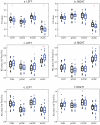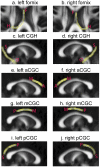Regionally specific white matter disruptions of fornix and cingulum in schizophrenia
- PMID: 21533181
- PMCID: PMC3077390
- DOI: 10.1371/journal.pone.0018652
Regionally specific white matter disruptions of fornix and cingulum in schizophrenia
Abstract
Limbic circuitry disruptions have been implicated in the psychopathology and cognitive deficits of schizophrenia, which may involve white matter disruptions of the major tracts of the limbic system, including the fornix and the cingulum. Our study aimed to investigate regionally specific abnormalities of the fornix and cingulum in schizophrenia using diffusion tensor imaging (DTI). We determined the fractional anisotropy (FA), radial diffusivity (RD), and axial diffusivity (AD) profiles along the fornix and cingulum tracts using a fibertracking technique and a brain mapping algorithm, the large deformation diffeomorphic metric mapping (LDDMM), in the DTI scans of 33 patients with schizophrenia and 31 age-, gender-, and handedness-matched healthy controls. We found that patients with schizophrenia showed reduction in FA and increase in RD in bilateral fornix, and increase in RD in left anterior cingulum when compared to healthy controls. In addition, tract-based analysis revealed specific loci of these white matter differences in schizophrenia, that is, FA reductions and AD and RD increases occur in the region of the left fornix further from the hippocampus, FA reductions and RD increases occur in the rostral portion of the left anterior cingulum, and RD and AD increases occur in the anterior segment of the left middle cingulum. In patients with schizophrenia, decreased FA in the specific loci of the left fornix and increased AD in the right cingulum adjoining the hippocampus correlated with greater severity of psychotic symptoms. These findings support precise disruptions of limbic-cortical integrity in schizophrenia and disruption of these structural networks may contribute towards the neural basis underlying the syndrome of schizophrenia and clinical symptomatology.
Conflict of interest statement
Figures








References
-
- Takei K, Yamasue H, Abe O, Yamada H, Inoue H, et al. Disrupted integrity of the fornix is associated with impaired memory organization in schizophrenia. Schizophrenia Research. 2008;103:52–61. - PubMed
-
- Fujiwara H, Namiki C, Hirao K, Miyata J, Shimizu M, et al. Anterior and posterior cingulum abnormalities and their association with psychopathology in schizophrenia: A diffusion tensor imaging study. Schizophrenia Research. 2007;95:215–222. - PubMed
-
- Mufson EJ, Pandya DN. Some observations on the course and composition of the cingulum bundle in the rhesus monkey. J Comp Neurol. 1984;225:31–43. - PubMed
Publication types
MeSH terms
LinkOut - more resources
Full Text Sources
Medical
Miscellaneous

